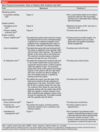RACS True/False Quiz 2018 Flashcards
(262 cards)
No difference in PROMs, complication or revision rates between mechanical and kinematic alignment TKR groups at 2 years.
True
But long-term data are still lacking
Mechanical alignment in TKR is created by making a femoral cut perpendicular to the anatomical axis of the femur
False
Increased failure rate in patients with femoral components in > 8º of anatomic valgus, in addition to tibial components positioned in > 3º of varus relative to the midline
True
Femoral components in kinematic knee are aligned in 2 to 4º more valgus and tibial components that are positioned in 2 to 4º more varus, while maintaining similar hip-knee-ankle angles
True
Studies show marked difference in Knee Society Scores at 3/12, 6/12, and 5 years postoperatively when compared CAS (computer assisted surgery i.e Navigation) to non-CAS TKA
False
Young and Burgess lateral compression never causes bleeding requiring angioembolization
False
Patterns most commonly requiring angioembolization are the Young and Burgess LC and APC types and Tile type C
Approximately 85% of bleeding associated with pelvic fractures is from veins or bones
True
Ligation of the internal iliac artery during laparotomy is an effective way to control pelvic arterial haemorrhage
False
Due to rich collaterals
Hemodynamic instability on presentation (defined as systolic arterial pressure ,90 mm Hg after an infusion of 2 L of lactated Ringer solution and the initiation of transfusion of packed red blood cells) as an indication to immediately perform angiography with embolization
True
Fractures through the sciatic notch are thought to be associated with a high rate of arterial injury
True
Because of the proximity of the superior gluteal artery
Patients who get embolization after pelvic injury have higher mortality rates
True
Because of substantial high-energy trauma with multiple injuries (Mortality of 16-50% reported)
Survival substantially improves when embolization is performed within 6 hours of arrival
False
Within 3 hours
Name the most commonly embolized arteries in pelvic fractures in decreasing order
Internal iliac & its branches, Sup Gluteal, Obturator, Internal pudendal
Inadequate response to initial resuscitation is very sensitive but not specific to predict arterial bleeding in angiography
True
100% sensitive and 30% specific
Pressures of only 10 mm Hg are require for tamponade of venous bleeding in the pelvis
True
Harder bearings (e.g. cobalt-chromium and ceramics) have lower wear rates than soft bearings because of lower surface roughness and less vulnerability to deformational forces
True
Ultra high–molecular weight polyethylene (UHMWPE) and XLP, have a lower Young modulus of elasticity and therefore exhibit higher deformation under force
False
Higher Young modulus of elasticity
UHMWPE has the highest surface roughness factor resulting in higher frictional forces during articulation and the generation of more wear particles than other bearing surfaces
True
Large cobalt-chromium femoral heads (>32 mm), when coupled with both UHMWPE and XLP, have demonstrated low volumetric wear rates because larger femoral heads have more surface area for articulation
False
Larger surface area= higher volumetric wear
Ceramic on-ceramic implants, given the nature of their smoother surfaces, have the best lubrication performance and can establish fluid-film lubrication at various femoral head sizes
True
Ceramic and metal are hydrophilic which aids in forming fluid film and fluid film lubrication
XLP is irradiated at 200 kGy to increase the cross-linking potential between free radicals
False
50-100. Higher doses will cause breakdown of the mechanical structure
The threshold for osteolysis resulting from polyethylene debris has been considered 0.10 mm/y for linear wear and 80 mm3/y for volumetric wear
True
Trunnion corrosion related to larger femoral head sizes, longer length of trunnion, smaller trunnion diameter, longer neck length, higher taper angle, lower flexural rigidity, and dissimilar alloy pairings
True
The bare area of the glenoid is thought to converge with the center of the inferior glenoid circle
True

















